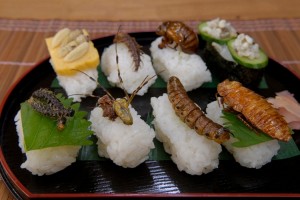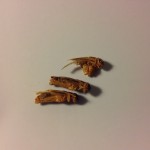As I promised last time, I tried out something that is everyday but fun at the same time. That is, I decided to prepare myself a dish made out of real insects. If my last blog was simply about tossing crickets into my mouth, (those I purchased from a vending machine with 1 dollar), this time it is more serious. In this blog, I will guide you through a new world of homemade insect dishes with a legitimate food recipe. 🙂
I hope you remember my last blog. In my previous blog I talked about how important it was for the global community to find a new source of food that can meet the growing calorie demand of the world. And my answer was “Bugs might be the bites!” Bugs are a wonderful source of healthy proteins, fats, vitamins and minerals. Silk Worm Pupae alone contain 9.6 grams of protein, 5.6 grams of fat, 2.3 grams of carbohydrate, 41.7 milligrams of calcium and 1.8 milligrams of iron. This is shockingly nutritious. The same amount of beef contains only 27.4 grams of protein and 3.5 grams of iron (Berendaum). You see what I am talking about?
Perhaps the only barrier that prevents many of us from enjoying insect meals is psychological, not physiological. Insects aren’t necessarily gross if we open our minds! Believe it or not, even lobster was considered as cockroaches of the sea and for a long time it was food for prisoners. Perceptions can change when food taste delicious. They can be gourmet cuisines!!!
To change these perceptions I went out shopping to purchase ingredients for my home-made traditional Korean insect dish. The insect I used for my dish is called Bundaegi.
Bundaegi are the pupae of the domesticated silk moth, Bombyx mori. Bombyx mori originally existed in the wild throughout Asia. However as the silk industry thrived in this region; there are only domesticated ones around us. The larvae of Bombyx mori are caterpillars that are normally 4 cm long with their horned cerci. A normal adult of Bombyx mori has a pair of 4 cm wings (Katie Clay). And we normally eat them when they are in their pupae stage.
Bombyx mori more commonly known as silkworm has been treasured by many Asian cultures as a nutritional supplement and traditional treatment for diabetes. According to the Science Daily, Bombyx mori indeed are rich with healthful Conjugated Linoleic Acid. Studies confirm that Conjugated Linoleic Acid has beneficial effects, including stimulation of the immune system, protection against cancer and heart disease, reducing body fat and controlling diabetes (Science Daily). Doesn’t this sound too good to be true? J
Traditionally, Bombyx mori have been a crucial component of textile industries. Believe it or not, these Bombyx mori were considered so valuable, there were cases where people got punished with death penalty for smuggling them. Also, because Bombyx mori have been cultivated for so long for sericulture, they cannot survive on their own but instead they always must be fed by humans (Lepidopetra Part 2).
Now back to business.
Once I purchased a can of pupae of Bundaegi, I searched the internet for the best recipe, which I can ACTUALLY try. Quite honestly cooking wasn’t as easy as I thought it would be. After some hodgepodge of chopping, slicing and boiling, I discovered that I would need onions, soy sauce, bell pepper, chili along with other numerous marinating techniques to make the perfect dish.
In sum? My first insect dish was a total failure. 🙁







